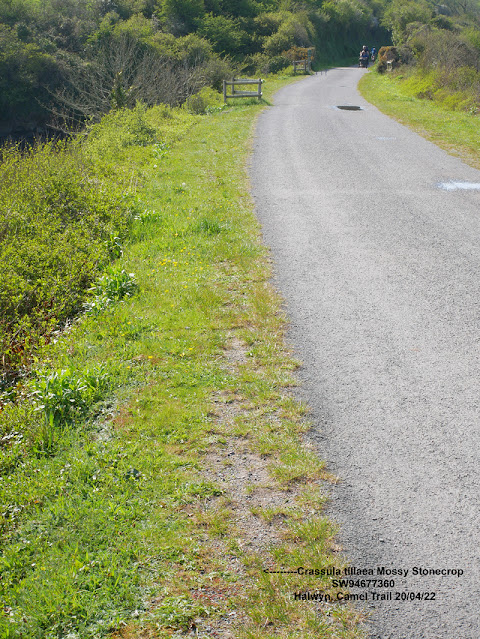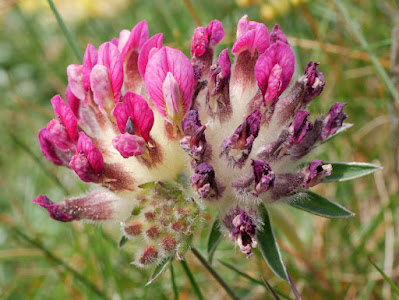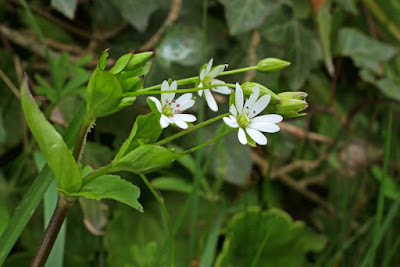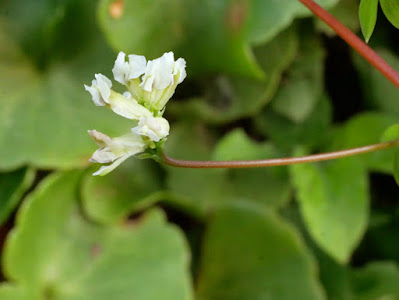More and more plants are coming into flower now, so many that I won't be able to keep up soon. The next few finds were all coastal, which is quite spectactular even without plants!
First venue was Par Sands near St Austell, all the way down to the south coast (about 18 miles).
This was the location of our nearest Range shop and I took the opportunity to have a look at Par sand dunes after shopping. I found some Sea Sandwort in flower rather early.
Honckenya peploides
Below is Sea mouse-ear which is usually in flower now.
It normally has 4 petals but sometimes can have 5, so beware! These are tiny by the way.
Cerastium diffusum
When one comes across a garden plant in the wild, it's worth recording it. In this case, I found Darwin's Barberry bush naturalised in the dunes. The nearest previous record was in St Austell on a wall, several miles away. Recording these shows their spread over the years.
Berberis darwinii
I had to take my partner to hospital for treatment to a broken finger, and that was miles away near Hayle. On the way home, I took the scenic route and stopped off near Godrevy Head for a look around and some superb scenery.
Those little blue specks above in the grass are a special little plant. They are called Spring Squill and though fairly common around the cliffs in Cornwall are non existent in the South East. As such, I'm not used to seeing them. Beautiful little flowers. Each flower is no larger than a 20p coin.
Scilla verna
One sunny day, we decided to take a short walk along the Camel Trail. This is a famous cycle track but its joint use with pedestrians and horse riders too. Here's some of the views along the way. It's made over a disused railway, the Wadebridge to Padstow line which incidentally, was the second ever passenger railway built in the world.
It was a bit of a pain dodging inconsiderate holidaymakers on hired bikes who didn't have a clue about biking and some rode straight at us expecting us to jump aside! Signs abounded stating pedestrians have priority, especially old codgers. OK, I made the last bit up.
However, the verges were full of wildflowers. Here is Little Robin, a rare plant nationally, but common around the old railway route. It's a lot smaller than Herb Robert and has yellow anthers. This one was high up on a wall, so I couldn't get any closer.
Geranium purpureum
Early Purple Orchids were numerous and just coming into bloom
Orchis mascula
The next plant doesn't look much, but it was a first for me. It's Mossy Stonecrop which starts off green and turns a striking red. Tiny flowers pop up in the axils but none were present yet. An exciting find.
Here's a habitat shot. You can see the plant just starting to turn the ground red to the left of the photo.
Crassula tillaea
On another day we took a cliff walk around Trevose Bay, a pretty beach near Padstow. I couldn't miss Wild Carrot, now in flower. You can't reliably tell subspecies apart until they seed. One subspecies has seedheads that fold into a ball, the other stays flat. Rather than carry a wide angle lens, I now use my phone camera for wide angle shots. Not as good as a wide angle, but good enough!
Daucus carota
A stand of Sea Campion around a massive sinkhole. Called Round Hole, old OS maps show it's been here for a century! The sea eroded under the cliffs 50m inland causing a collapse. The tide comes in through a small tunnel and it fills with water. It was a good 100 feet down!
Silene uniflora
Around the sandy car park were numerous plants of Wild Clary. I like it, but most people don't even notice it.
Salvia verbenaca
I came across some amazing Kidney Vetch variants. The usual form is yellow with a red variant named and known. Here's the red form.
Anthyllis vulneraria subsp vulneraria var coccinea
However, I kept finding another form with yellow wings and red standard and keel petals. They looked like "Wow!" For some reason (maybe they are new to science) they don't have a varietal name, so I've made one up.
Anthyllis vulneraria subsp vulneraria var heterochromia
heterochromia translated from the Greek, means "dual coloured" so I thought that was an apt name.
Here's the usual yellow form against another stunning view.
I'll be returning to the coasts a lot soon as all the rarities that I've never seen will be coming into flower next month. Next up, I'm back to woodland, country lanes and of course at least one bog!
Take care
Dave
Follow me on Twitter: @botany2021








































































